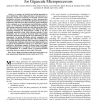Free Online Productivity Tools
i2Speak
i2Symbol
i2OCR
iTex2Img
iWeb2Print
iWeb2Shot
i2Type
iPdf2Split
iPdf2Merge
i2Bopomofo
i2Arabic
i2Style
i2Image
i2PDF
iLatex2Rtf
Sci2ools
TVLSI
2002
2002
Electrical and optical clock distribution networks for gigascale microprocessors
A summary of electrical and optical approaches to clock distribution within high-performance microprocessors is presented. System-level properties of intrachip electrical clock distribution networks corresponding to three microprocessor families are summarized. It is found that global clock interconnect performance and short-term jitter present the greatest challenges to the continued use of conventional clock distribution methodologies. An extrapolation of trends describing the percentage of clock period consumed by global skew and short-term jitter identifies the 32-nm technology generation of the 2002 International Technology Roadmap for Semiconductors (ITRS) as the first technology generation within which alternate methods of clock distribution may be warranted. Research efforts investigating interboard through intrachip optical clock distribution are also summarized. An optical distribution network compatible with high volume manufacturing in conjunction with a suitable means of p...
| Added | 23 Dec 2010 |
| Updated | 23 Dec 2010 |
| Type | Journal |
| Year | 2002 |
| Where | TVLSI |
| Authors | A. V. Mule, Elias N. Glytsis, Thomas K. Gaylord, James D. Meindl |
Comments (0)

